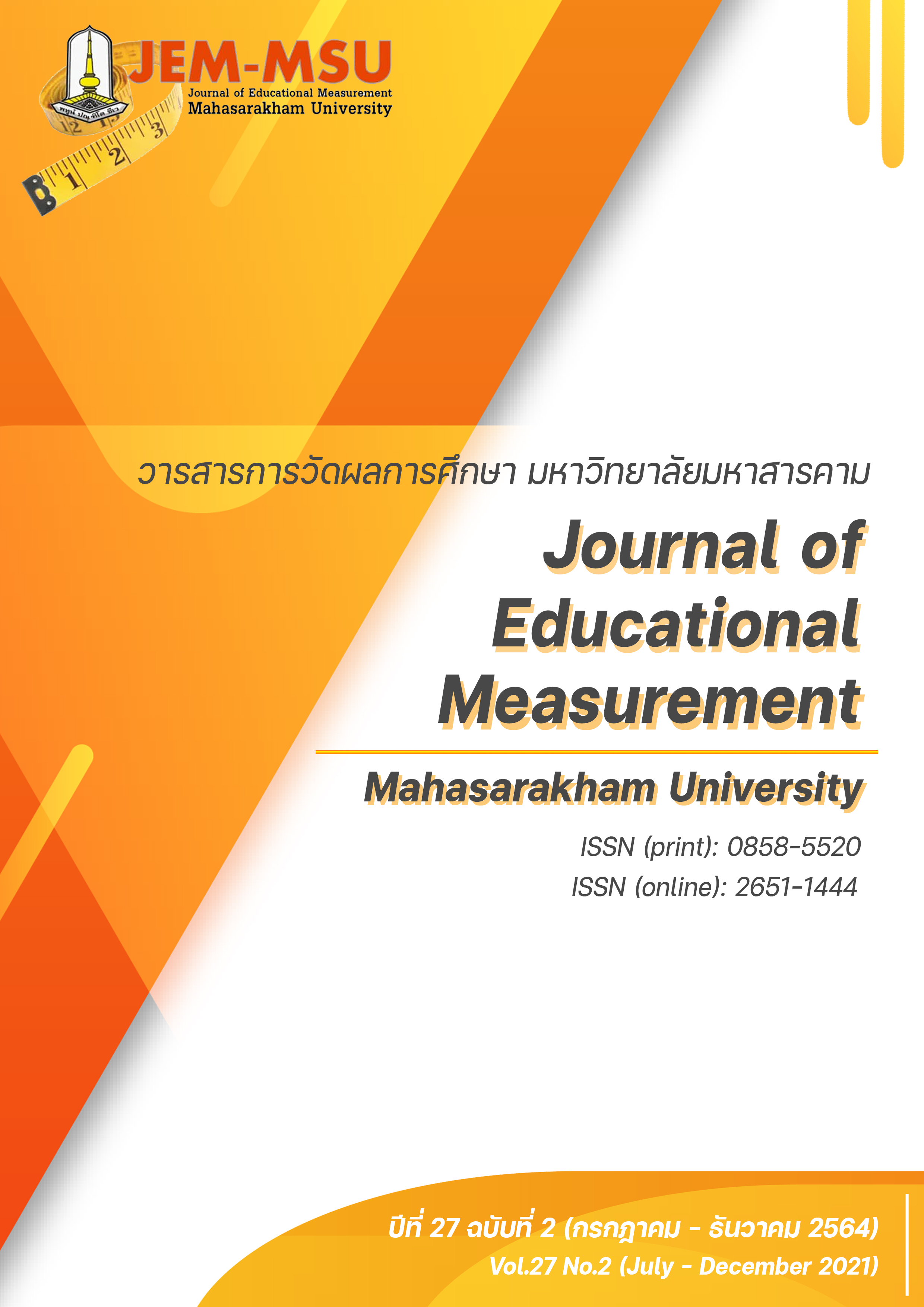Innovation in Organizing for Learning Based on Sufficiency Economy Philosophy, Using the Professional Learning Community
Main Article Content
Abstract
This research aimed to 1) study innovation and components of innovation, 2) develop innovation, 3) study the factors that affect the application of innovation, 4) study the results of the application of innovation, and 5) evaluate the innovation. The research employed research and development methodology (R&D), consisting of 5 phases as follows: 1) quantitative research (R1), dealing with the study of the types and components of innovation. The target group consisted of 800 teachers who were selected through multi-stage randomization. The instrument was a questionnaire; 2) development (D1), dealing with creation of an innovation in organizing for learning based on the Sufficiency Economy Philosophy, having the innovation assessed by experts, using an assessment form, and followed by a tryout of the innovation; 3) quantitative research (R2) dealing with the study of the factors that affect the implementation of the innovation. The target group consisted of 384 teachers. The instrument was a questionnaire. 4) experimental research (R3), dealing with trying out the innovation following quasi-experimental time-series design. The activities were carried out through professional learning community, consisting of 3 phases: 4.1) collecting data on organizing for learning from 15 purposively-selected teachers who volunteered to dedicate time to participate in the study, in 2019; 4.2) developing the 15 teachers on their teaching by training, using the innovation in organizing for learning based on the Sufficiency Economy Philosophy, following quasi-experimental one group pre-posttest design. After the training, the pretest and posttest scores were compared, using t–test; and 4.3) studying the outcomes of the teachers’ teaching; and 5) evaluation research (R4), dealing with an evaluation according to the CIPP model by giving a questionnaire to the 15 teachers and another questionnaire to 300 students who had learned with the teachers, 20 from each classroom.
The findings were as follows: 1) the innovation in organizing for learning based on the Sufficiency Economy Philosophy, which means using the Sufficiency Economy Philosophy as the basis of the development of the innovation in organizing for learning, consisted of 8 components: 1.1) the process of organizing for learning, 1.2) objectives, 1.3) principles, 1.4) measurement and evaluation, 1.5) philosophy, 1.6) theory, 1.7) goals, 1.8) knowledge management, drawing the lessons and best practice; 2) the model of organizing for learning based on the Sufficiency Economy Philosophy consisted of 8 components: 1. philosophy, 2. theory, 3. principles, 4. goals, 5. objectives, 6. the process of organizing for learning, 7. measurement and evaluation, and 8. knowledge management, drawing the lessons and best practice; 3) the factors that affected the authentic implementation of the innovation in organizing for learning based on the Sufficiency Economy Philosophy (Y) included: the atmosphere of organizing for learning (A), the teacher (B), the innovation (C), the environmental setting (D), and the learners (E). It was predicted that the learners could actually use 61.8% of the content, as represented by the equation of the following raw and standard scores.
Y= 1.179 + .481 (A) + .503 (B) + .506 (C) + .391 (D) + .389 (E)
Z= .330 (A) + .283(B) + .453(C) + .281(D) + .245(E)
4) The results of the implementation showed that teachers can organize for learning according to the model of organizing for learning by using the following topic questions: 1) What to know? 2) How much to know? and 3) Where to know? These questions can make students enthusiastic about learning and being technology-driven in their study. 5) The results of the CIPP model assessment on the satisfaction of both the teachers and students with the innovation, on the whole, were at the high level ( = 4.33, S.D. =.02).
Article Details
The content and information contained in the published article in the Journal of Educational Measurement Mahasarakham University represent the opinions and responsibilities of the authors directly. The editorial board of the journal is not necessarily in agreement with or responsible for any of the content.
The articles, data, content, images, etc. that have been published in the Journal of Educational Measurement Mahasarakham University are copyrighted by the journal. If any individual or organization wishes to reproduce or perform any actions involving the entirety or any part of the content, they must obtain written permission from the Journal of Educational Measurement Mahasarakham University.
References
กระทรวงศึกษาธิการ. (ม.ป.ป.). คู่มือประกอบการอบรมการขับเคลื่อนกระบวนการ PLC (Professional Learning Community) “ชุมชนการเรียนรู้ทางวิชาชีพ” สู่สถานศึกษา. กรุงเทพฯ: สำนักพัฒนาครูและบุคลากรการศึกษาขั้นพื้นฐานสำนักงานคณะกรรมการการศึกษาขั้นพื้นฐาน.
กระทรวงศึกษาธิการ. (2558). ประกาศกระทรวงศึกษาธิการ เรื่อง นโยบายการขับเคลื่อนปรัชญาของเศรษฐกิจพอเพียง. กรุงเทพฯ: กระทรวงศึกษาธิการ.
สำนักงานคณะกรรมการพัฒนาการเศรษฐกิจและสังคมแห่งชาติ. (2556). สัจจธรรมแห่งแนวพระราชดำริสู่การพัฒนาอย่างยั่งยืน. กรุงเทพฯ: อมรินทร์พริ้นติ้งแอนด์พับลิชชิ่ง จำกัด (มหาชน).
จำเนียร จินตนา. (2552). การพัฒนากิจกรรมการเรียนรู้ เรื่อง ชีวิตกับสิ่งแวดล้อมตามแนวทางปรัชญาเศรษฐกิจพอเพียง. การศึกษาตามหลักสูตรปริญญาวิทยาศาสตรมหาบัณฑิต สาขาสิ่งแวดล้อมศึกษา มหาวิทยาลัยมหาสารคาม.
ไชยรัตน์ ปราณี และคณะ. (2553). รูปแบบการจัดการเรียนรู้เพื่อเสริมสร้างคุณลักษณะความสมานฉันท์ของเยาวชนไทย. นครสวรรค์: คณะครุศาสตร์ มหาวิทยาลัยราชภัฏนครสวรรค์.
ฐิติมน ทองพิมพ์. (2551). สภาพการใช้ปรัชญาเศรษฐกิจพอเพียงในการจัดการเรียนรู้ของครู วิทยาลัยเกษตรและเทคโนโลยีเชียงใหม่. เชียงใหม่: บัณฑิตวิทยาลัยมหาวิทยาลัยเชียงใหม่.
ทิศนา แขมมณี. (2555). ศาสตร์การสอน: องค์ความรู้เพื่อการจัดกระบวนการเรียนรู้ที่มีประสิทธิภาพ. กรุงเทพฯ: จุฬาลงกรณ์มหาวิทยาลัย.
ธนชัย ใจสา. (2561). การพัฒนารูปแบบการสอนโดยใช้ทฤษฎีการสร้างความรู้ด้วยตนเอง และทฤษฎี การเรียนรู้แบบร่วมมือเพื่อพัฒนาความสามารถในการแก้ปัญหาของนักเรียนชั้นประถมศึกษาปีที่ 2. ภาคหลักสูตรและการสอน. [ออนไลน์]. แหล่งที่มา: http://www.bsru.ac.th/identity/archives/1568. [9 พฤษภาคม 2561].
ปรียานุช พิบูลสราวุธ. (2550). ปรัชญาของเศรษฐกิจพอเพียงตามแนวพระราชดำริ. กรุงเทพฯ: โครงการวิจัยเศรษฐกิจพอเพียง สำนักงานทรัพย์สินส่วนพระมหากษัตริย์.
ปาจรีย์ คุ้มสิงห์สันต์. (2560). ปัจจัยที่ส่งผลต่อการจัดการเรียนรู้ทักษะกระบวนการทางวิทยาศาสตร์ของครู ที่สอนวิทยาศาสตร์ สังกัดสำนักงานเขตพื้นที่การศึกษาประถมศึกษาเพชรบูรณ์ เขต 3. การประชุมวิชาการระดับชาติ มหาวิทยาลัยราชภัฏเพชรบูรณ์ ครั้งที่ 4 วันที่ 10 มีนาคม 2560 ณ มหาวิทยาลัยราชภัฏเพชรบูรณ์.
พระฉัตรชัย ศรีน้อยขาว. (2552). การพัฒนาแผนการจัดการเรียนรู้สิ่งแวดล้อมศึกษาแบบบูรณาการปรัชญาเศรษฐกิจพอเพียงกับหลักธรรมทางพุทธศาสนา สำหรับนักเรียนช่วงชั้นที่ 2. การศึกษาตามหลักสูตรปริญญาวิทยาศาสตรมหาบัณฑิต สาขาวิชาสิ่งแวดล้อม มหาวิทยาลัยมหาสารคาม.
มูลนิธิชัยพัฒนา. (2553). ปรัชญาของเศรษฐกิจพอเพียง. วารสารมูลนิธิชัยพัฒนา, 2553 (ฉบับเดือนธันวาคม) 16.
สมศักดิ์ เตชะโกสิต (2559). รูปแบบการเรียนรู้จินตวิศวกรรมทางวิทยาศาสตร์ด้วยเทคโนโลยีความเป็นจริงเสริมเพื่อการรู้สะเต็ม. วิทยานิพนธ์สาขาวิชาเทคโนโลยีสารสนเทศและการสื่อสารเพื่อการศึกษา มหาวิทยาลัยเทคโนโลยีพระจอมเกล้าพระนครเหนือ.
สำนักงานคณะกรรมการการศึกษาขั้นพื้นฐาน กระทรวงศึกษาธิการ. (2550). แนวทางการจัดทำหน่วย การเรียนรู้แบบบูรณาการปรัชญาเศรษฐกิจพอเพียง. กรุงเทพฯ: กระทรวงศึกษาธิการ.
อรวรรณ ป้อมคำ. (2560). เศรษฐกิจพอเพียงกับการศึกษา. [ออนไลน์]. แหล่งที่มา: https://sites.google. com/site/nirattisai071/sersthkic-phx-pheiyng-kab-kar-suksa. [9 พฤษภาคม 2560].
Dick, W. & Carey, L. (1996). The systematic design of instruction. 4th ed. New York: Harper Collins.
Hair, J. F. Jr. Black, W. C., Babin, B. J. Anderson, R. E. and Tatham, R. L. (2006). Multivariate data analysis. 6th ed. New Jersey: Prentice Hall.
Joyce, B, & Weil, M. (1996). Model of teaching. 5thed. Boston: Allyn and Bacon.


